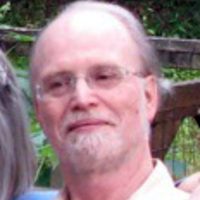Papers by Claude M Le Pape
Proceedings IROS '91:IEEE/RSJ International Workshop on Intelligent Robots and Systems '91
... create orders from clients (such as BOB: give book B to TOM) and send them to a central sys... more ... create orders from clients (such as BOB: give book B to TOM) and send them to a central system called CTPS (Central Task Planner and Scheduler ... The last part ... First a generic simulation system allows to simulate the actions of multiple agents given a de-scription of each agent ...

L'objectif initial de ce document, redige avec l'aide de tout le bureau de la ROADEF, eta... more L'objectif initial de ce document, redige avec l'aide de tout le bureau de la ROADEF, etait de presenter la RO-AD a l'Academie des Technologies (d'aprs une idee de Catherine Roucairol). Ce text a ete communique a l'Academie des Technologies, et a l'heure actuelle nous en attendons le retour. Quoiqu'il en soit, nous avons juge interessant de vous faire connaitre ce texte afin que vous puissiez le critiquer (surement), vous l'appropier (nous l'esperons), et le reutiliser si vous le jugez utile. La presentation que nous faison de la RO-AD peut parraitre restrictive, si l'on s'appuie sur l'idee que la RO-AD est "la science de la decisin", ou de "l'aide a la decision". Les disciplines qui font de l'aide a la decision sont tres nombreuses aujourd'hui et toutes ne font pas de la RO-AD (imagerie medicale, traitement du signal, ingenierie financiere, pour ne prendre que ces trois exemples). Il nous a semble important de bien circonscrire la definition de la discipline pour la rendre plus facile a comprendre et a identifier, bref plus lisible. Ce texte n'est pas parfait. Mais il est.
HAL (Le Centre pour la Communication Scientifique Directe), Jun 1, 2005
Page 23. Une nouvelle approche de l'intégration de la planification de production et de l&#x... more Page 23. Une nouvelle approche de l'intégration de la planification de production et de l'ordonnancement Anna Robert1, 2, Claude Le Pape1, Frédéric Paulin1, Francis Sourd2 1 ILOG SA, 9 rue de Verdun 94253 Gentilly cedex {anrobert, clepape, fpaulin}@ ilog. ...
Energy Procedia, Aug 1, 2015
In order to improve the efficiency of drink pipes, which optimizes pumping scheduli network const... more In order to improve the efficiency of drink pipes, which optimizes pumping scheduli network constraints on a daily basis. We strongly on the characteristics of the networ

IFIP advances in information and communication technology, 1995
An important distinction is made in the planning domain between predictive planning problems and ... more An important distinction is made in the planning domain between predictive planning problems and reactive execution problems [ 1]. The following paper discusses the distinction in the case of manufacturing scheduling. Given a set of jobs, an ordered set of production steps for each job, and a set of machines to perform these production steps, the predictive scheduling problems consists in determining an aJ)propriate allocation of production steps to machines over time. Given partial or complete information about the current state of the manufacturin?, system, the reactive execution (or dispatching) problem consists in deciding "in real-time' which production steps to execute next on each machine. The paper presents an architecture allowing to associate a predictive scheduler and a reactive dispatcher. The predictive scheduler constructs a predictive schedule and updates it occasionally in response to arising problems and opportunities (in this sense, the predictive scheduler is a bit reactive!). The reactive dispatcher decides in real-time which operations to start on the shop floor g1ven the actual course of events. It relies on the schedule to make its decisions, but overrides it in response to arising problems and opportunities. Our implementation allows the user to tune the oehavior of both the predictive scheduler and the reactive dispatcher, and therefore to compare various couplings of predictive and reactive scheduling procedures. Experimental results provide evidence that mdependent settings of predictive sclieduling and reactive execution algorithms can result in poor performance on the shop-floor.
Nowadays, elevators are equipped with storage devices to ensure autonomy in case of grid failure.... more Nowadays, elevators are equipped with storage devices to ensure autonomy in case of grid failure. This paper presents a method that takes advantage of these storage devices to optimize energy consumption and cost. The optimization is achieved by two controllers: a high-level one (using linear programming) and a low-level one (using simple rules). Preliminary results indicate that this method is 35% better than a naive rule-based approach in our context.

HAL (Le Centre pour la Communication Scientifique Directe), Jul 1, 2007
Generally, APS (Advanced Planning and Scheduling software) manage two modules to solve production... more Generally, APS (Advanced Planning and Scheduling software) manage two modules to solve production planning and scheduling. At first, an optimized plan is computed, it answers the following question : how much material has to be produced, and in which time period, so as to satisfy the demand (which is distributed over the time horizon) (see lot sizing problem definition [8, 2, 5, 1, 3]). Then, the plan is transmitted to the scheduling module that has to compute a solution as good as possible, giving the start time for each production activity and the required resource, taking into account precised resource constraints. The transition from planning to scheduling is not as direct as it seems : quantities planned to be produced in a given period have to be cut into batches in order to meet batch size limits, which depict hard physical constraints or economic preferences. APS usually integrate batch dimensioning (batching) in one module or the other, depending on the context (process industry, food and beverage. . . ) and also on the techniques of resolution. However, none of these approaches considers batching as a real optimization problem, that can be solved apart from planning and scheduling. ILOG APS Plant PowerOps introduces an intermediate module dedicated to the batching problem. Not only this third module optimizes the batch dimensioning (we will see in the following with regard to which criteria), but it also establishes a complete flow of material tranferred between entities of the production chain : stocks, batches and final demands. We call the problem of defining such a flow, the pegging problem (see [4, Chapter 3, Section 6] and [7]). The addition of this new module allows to increase consistency between plan and schedule, since adding an intermediate step softens the transition between mid and short terms by integrating some planning and scheduling constraints.
The goal of the GOFER project is to control the operations of many mobile robots (several dozens)... more The goal of the GOFER project is to control the operations of many mobile robots (several dozens) in an indoor environment. This project raises many research issues: implementation of nonconflicting sensor systems, man-robot and robot-robot communication systems and protocols, contingency-tolerant motion control, multi-robot motion planning, multi-robot task planning and scheduling. The aim of this paper is to provide an overview
HAL (Le Centre pour la Communication Scientifique Directe), Feb 1, 2006
Dans l’industrie de transformation, les decisions liees a la planification de la production d’une... more Dans l’industrie de transformation, les decisions liees a la planification de la production d’une part, et a l’ordonnancement d’autre part, sont determinantes pour une exploitation efficace de la chaine de production. En vue d’une bonne integration de ces deux problemes, nous proposons un modele de resolution sequentielle en trois phases. Un probleme intermediaire entre la planification et l’ordonnancement est resolu. Il consiste a prendre des decisions sur la taille des lots (lot streaming) et les flux de materiaux (pegging) tout au long de la chaine de production. Nous formulons ce probleme par un programme lineaire en nombres entiers que nous resolvons par branch and bound et analysons ses performances par rapport a une resolution heuristique.
As the interest in regulating energy usage and in the demand-response market is growing, new ener... more As the interest in regulating energy usage and in the demand-response market is growing, new energy management algorithms emerge. In this paper, we propose a formalization of "the sourcing problem" and its application to a multisource elevator. We propose a linear formulation that, coupled with a low level rulebased controller, can solve this problem. We show in the experiments that a compromise between reducing consumption peaks and minimizing the energy bill has to be reached. 2 THE SOURCING PROBLEM We call "prosumers", entities that consume and/or produce energy. An energy hub allows each prosumer to consume power produced by all other prosumers at the same time. Definition 1. Let P be a set of n p prosumers, all connected to the same energy hub h.
Energy Procedia, Aug 1, 2015
For historical reasons, many large industria was isolated when built up or the local netw for ene... more For historical reasons, many large industria was isolated when built up or the local netw for energy-intensive industries like refineri industries or chemical plants for instance. T concern being the safety of the process. Th the industrial plant operator, considering int Laying on the mathematical description of First, to develop a standard architecture th how high the expected savings could go an refinery case study, where the expected ea figures obtained show that this is a relev studies are being considered, from cement p

In this chapter we investigate the problem of energy optimization of a Multisource Elevator. We p... more In this chapter we investigate the problem of energy optimization of a Multisource Elevator. We propose a large framework including a strategic optimizer and a local controller. The roles and influences of these systems depend on the time horizon fixed. The first one proposes the strategy for the next hour, where the second tries to re-adapt the long term strategy to the real-time constraints. We prove the adaptability of this approach to real-time conditions (e.g.: disruptions of the forecasted elevator travels). In such a context, a linear programming formulation has been developed, coupled with a low level rule-based controller. We propose three main objective functions for the sourcing problem, that can be studied together or one after each other. Then, we tackle a specialized sourcing problem: the Multisource Elevator problem in which the three objectives have to be achieved simultaneously. We show in the experiments, based on real data sets, that a compromise between reducing ...

Advances in Intelligent Systems and Computing, 2017
As the interest in regulating energy usage and participating in the demand-response market is gro... more As the interest in regulating energy usage and participating in the demand-response market is growing, new energy management algorithms emerge. Energy consumption of elevators represents about 5% of the overall consumption of a building. Thus, improving energy performance of elevators becomes a relevant challenge. In this paper, a method is described to assist potential customers in choosing the most relevant storage units and control method for their multisource elevator. In order to obtain a certification on electricity cost savings and maximum power peaks, a randomized algorithm is designed. The best storage units design is found for a given use case, and a guarantee (with a fixed probability) is given that the elevator's consumption from the grid will not exceed a given power peak. Moreover, a similar guarantee is given on the minimum savings that could be achieved, choosing a given controller.
2016 IEEE Symposium Series on Computational Intelligence (SSCI), 2016
We tackle a production scheduling problem in a manufacturing system. The aim is to design an effi... more We tackle a production scheduling problem in a manufacturing system. The aim is to design an efficient exact method and find a trade-off between tardiness, storage and energy costs described by a piecewise-linear function. Therefore, we propose two time-based MILP formulations. The first one is precedence-oriented and the second is storage-oriented. These two formulations are compared and tested on realistic instances in order to show their limits. Good solutions are obtained, even on the biggest instance.
Proceedings., IEEE International Conference on Robotics and Automation
... We first present individual planning techniques. Then we describe a frame-work allowing robot... more ... We first present individual planning techniques. Then we describe a frame-work allowing robots to exchange information with a central system able to optimize task allocation. ... Section 2 presents individual planning techniques. ...
[1989] Proceedings of the Twenty-Second Annual Hawaii International Conference on System Sciences. Volume III: Decision Support and Knowledge Based Systems Track
SONIA is a job-shop scheduling system designed to detect and react to inconsistencies between a s... more SONIA is a job-shop scheduling system designed to detect and react to inconsistencies between a scheduling plan and the actual events on a shop floor. It is provided with a BB1-like blackboard architecture for coordinating the activation of various scheduling and analyzing knowledge sources. Most of the knowledge sources used by SONIA are flexible, allowing improvement of the efficiency of SONIA's problem-solving. The authors investigate and discuss the various types of behavior that knowledge sources for scheduling and analyzing can have

Applied Energy, 2017
We address the day-ahead pump scheduling problem for a class of branched water networks with one ... more We address the day-ahead pump scheduling problem for a class of branched water networks with one pumping station raising water to tanks at different places and levels. This common class is representative of rural drinking water distribution networks, though not exclusively so. Many sophisticated heuristic algorithms have been designed to tackle the challenging general problem. By focusing on a class of networks, we show that a pure model-based approach relying on a tractable mathematical program is pertinent for real-size applications. The practical advantages of this approach are that it produces optimal or near-optimal solutions with performance guarantees in near real-time, and that it is replicable without algorithmic development. We apply the approach to a real drinking water supply system and compare it to the current operational strategy based on historical data. An extensive empirical analysis assesses the financial and practical benefits: (1) it achieves significant savings in terms of operation costs and energy consumption, (2) its robustness to dynamic pricing means that demand-response can be efficiently implemented in this type of energy-intensive utility.
HAL (Le Centre pour la Communication Scientifique Directe), 2018
Dix recommandations 37 Un modèle pour comprendre la transformation numérique 17 Annexe 53 Sommair... more Dix recommandations 37 Un modèle pour comprendre la transformation numérique 17 Annexe 53 Sommaire FutuRIS a pour mission d'analyser et de mettre en perspective les évolutions du système français de recherche et d'innovation, à partir de travaux collaboratifs impliquant des acteurs d'horizons divers. L'objectif est d'accompagner le changement en l'éclairant de regards prospectifs partagés, et d'aider à faire progresser les stratégies et les coopérations. Etablissement public placé sous la protection du Président de la république, l'Académie des technologies propose aux autorités gouvernementales et à la société civile sur chaque sujet des grilles de lecture permettant l'évaluation des choix scientifiques et technologiques à faire. L'Académie s'implique aussi dans un dialogue constructif entre les parties prenantes.











Uploads
Papers by Claude M Le Pape